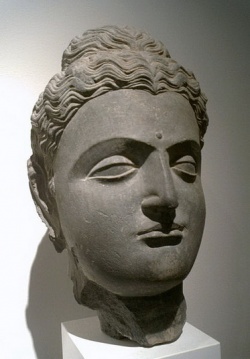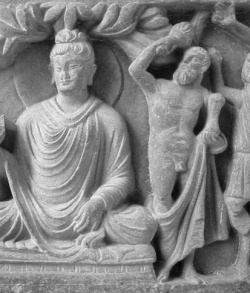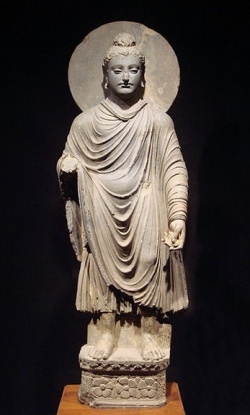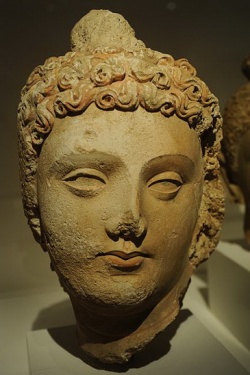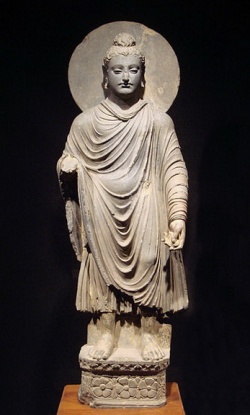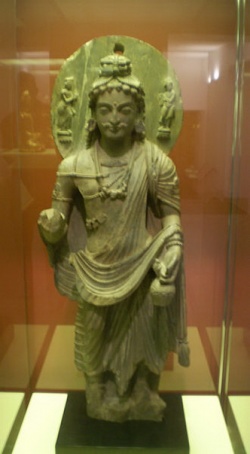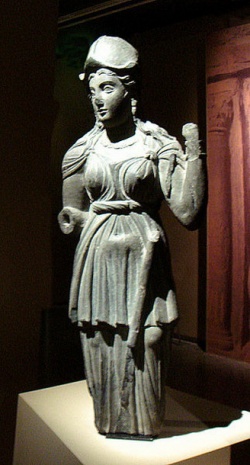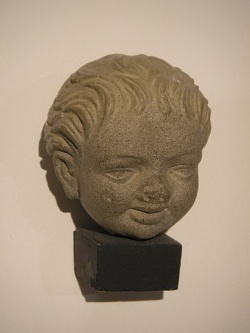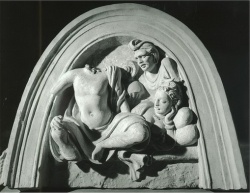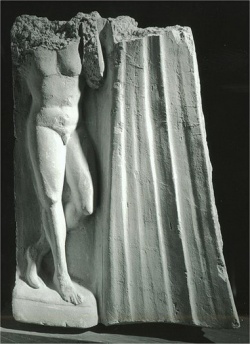Gandhara
Gandhāra (Sanskrit: गन्धार, Persian: ویهیند, Urdu: گندھارا) is an ancient kingdom (Mahajanapada), located in parts of modern-day northern Pakistan and eastern Afghanistan.
Gandhara was located mainly in the Peshawar Valley, the Pothohar Plateau and the Kabul River Valley.
Its main cities were Purushapura (modern Peshawar), literally meaning "city of men", and Takshashila (modern Taxila) .
The Kingdom of Gandhara lasted from the early 1st millennium BC to the 11th century AD.
It attained its height from the 1st century to the 5th century under the Buddhist Kushan Kings.
The Hindu term Shahi is used by history writer Al-Biruni to refer to the ruling Hindu dynasty that took over from the Turki Shahi and ruled the region during the period prior to Muslim conquests of the 10th and 11th centuries.
After it was conquered by Mahmud of Ghazni in 1021 CE, the name Gandhara disappeared. During the Muslim period the area was administered from Lahore or from Kabul.
During Mughal times the area was part of Kabul province.
Etymology
The name Gandhara is of Sanskrit origin, but its ultimate etymology is uncertain.
The region was first mentioned in the Rig-Veda. One proposed origin of the name is from the Sanskrit word gandha, meaning perfume and "referring to the spices and aromatic herbs which they [the inhabitants] traded and with which they anointed themselves."
Geography
The Gandhāri people were settled since the Vedic times on the banks of Kabul River (river Kubhā or Kabol) down to its confluence with the Indus.
Later Gandhāra included parts of northwest Punjab. Gandhara was located on the northern trunk road (Uttarapatha) and was a center of international commercial activities.
It was an important channel of communication with ancient Iran, India and Central Asia.
The boundaries of Gandhara varied throughout history.
Sometimes the Peshawar valley and Taxila were collectively referred to as Gandhara and sometimes the Swat valley (Sanskrit: Suvāstu) was also included.
The Heart of Gandhara, however, was always the Peshawar valley.
The kingdom was ruled from capitals at Kapisa (Bagram), Pushkalavati (Charsadda), Taxila, Purushapura (Peshawar) and in its final days from Udabhandapura (Hund) on the Indus.
According to the Puranas, Taxila and Pushkalvati were named after Taksha and Pushkara, the two sons of Bharata, a prince of Ayodhya.
History
Evidence of Stone Age human inhabitants of Gandhara, including stone tools and burnt bones, was discovered at Sanghao near Mardan in area Caves.
The artefacts are approximately 15,000 years old. More recent excavations point to 30,000 years before present.
The region shows an influx of southern [[Wikipedia:Central Asian|Central Asian]] culture in the Bronze Age with the Gandhara grave culture, likely corresponding to immigration of Indo-Aryan speakers and the nucleus of Vedic civilisation.
This culture survived till 1000 BC. Its evidence has been discovered in the hilly regions of Swat and Dir, and even at Taxila.
The name of the Gandhāris is attested in the Rigveda (RV 1.126.7 ) and in ancient inscriptions dating back to Achaemenid Persia.
The Behistun inscription listing the 23 territories of King Darius I (519 BC) includes Gandāra along with Bactria and Thatagush (ϑataguš, Satagydia).
In the book "Histories" by Herodotus, Gandhara is named as a source of tax collections for King Darius.
The Gandhāris, along with the Balhika (Bactrians), Mūjavants, Angas, and the Magadhas, are also mentioned in the Atharvaveda (AV 5.22.14), as distant people.
Gandharas are included in the Uttarapatha division of Puranic and Buddhistic traditions.
The Aitareya Brahmana refers to king Naganajit of Gandhara who was a contemporary of Janaka, king of Videha.
Epic and Puranic traditions
Gandhara had played an important role in the epic of Ramayana and Mahabharata.
Ambhi Kumar was direct descendant of Bharata (of Ramayana) and Shakuni (of Mahabharata).
It is said that Lord Rama consolidated the rule of the Kosala Kingdom over the whole of the Indian peninsula. His brothers and sons ruled most of the Janapadas (16 states) at that time.
In Mahabharata, the princess named Gandhari was married to Hastinapur's blind king Dhritrashtra and was mother of Duryodhana and other Kauravas.
The prince of Gandhara Shakuni was against this Wedding but accepted it, fearing an invasion from Hastinapur.
In the aftermath, Shakuni influences the Kaurava prince Duryodhana and plays a central role in the great War of Kurukshetra that eliminated the entire Kuru family, including Bhishma and a hundred Kaurava brothers.
According to Puranic traditions, this country (Janapada) was founded by Gandhāra, son of Aruddha, a descendant of Yayāti.
The princes of this country are said to have come from the line of Druhyu, who was a king of the Druhyu tribe of the Rigvedic period. According to Vayu Purana (II.36.107), the Gandharas were destroyed by Pramiti, aka Kalika, at the end of Kaliyuga.
Mother Goddess (fertility divinity), derived from the Indus Valley Civilization, terracotta, Sar Dheri, Gandhara, 1st century BC, Victoria and Albert Museum.
Gandhāra is also Thought to be the location of the mythical Lake Dhanakosha, the birthplace of Padmasambhava, the founder of Tibetan Buddhism.
The bKa' brgyud (Kagyu) sect of Tibetan Buddhism identifies the lake with the Andan Dheri Stupa, located near the tiny village of Uchh near Chakdara in the lower Swat Valley.
A spring was said to flow from the base of the Stupa to Form the lake. Archaeologists have found the Stupa but no spring or lake can be identified.
Pushkalavati and Prayag
The primary cities of Gandhara were Purushapura (now Peshawar), Takshashila (or Taxila) and Pushkalavati.
The latter remained the capital of Gandhara down to the 2nd century AD, when the capital was moved to Peshawar.
An important Buddhist shrine helped to make the city a centre of pilgrimage until the 7th century.
Pushkalavati in the Peshawar Valley is situated at the confluence of the Swat and Kabul rivers, where three different branches of the River Kabul meet.
That specific place is still called Prang (from Prayāga) and considered sacred and where local people still bring their dead for burial.
Similar geographical characteristics are found at site of Prang in Kashmir and at the confluence of the Ganges and Yamuna, where the sacred city of Prayag is situated, west of Benares.
Prayāga (Allahabad) one of the ancient pilgrim centres of India as the two rivers are said to be joined here by the underground Sarasvati River, forming a triveṇī, a confluence of three rivers.
The Gandharan city of Taxila was an important Buddhist centre of learning from the 5th century BC to the 2nd century.
Persian rule
Cyrus the Great (558–530 BC) united the Iranian people in to a state that stretched from Caucasus to the non-Iranic areas around the Indus River.
Both Gandhara and Kamboja soon came to be included under this state which was governed by the Achaemenian Dynasty during the reign of Cyrus the Great or in the first year of Darius I.
The Gandhara and Kamboja had constituted the seventh satrapies (upper Indus) of the Achaemenid Empire.
When the Achamenids took control of this kingdom, Pushkarasakti, a contemporary of king Bimbisara of Magadha, was the king of Gandhara.
He was engaged in a Power struggle against the kingdoms of Avanti and Pandavas.
The inscription on Darius' (521–486 BC) tomb at Naqsh-i-Rustam near Persepolis records GADĀRA (Gandāra) along with HINDUSH (Hənduš, Sindh) in the list of satrapies.
Under the Persian rule, a system of centralised administration with a bureaucratic system was introduced in the region. Great scholars such as Panini and Kautilya lived in this cosmopolitan environment.
The Kharosthi alphabet, derived from the one used for Aramaic (the official Language of Achaemenids) developed here and remained national script of Gandhara until 3rd century AD.
By about 380 BC Persian hold on the region weakened.
Many small kingdoms sprang up in Gandhara. In 327 BC Alexander the Great conquered Gandhara as well as the Indian Satrapies of the Persian Empire.
The expeditions of Alexander were recorded by his court historians and by Arrian (around AD 175) in his Anabasis Alexandri and other chroniclers many centuries after the event.
The companions of Alexander the Great did not record the names of Kamboja and Gandhara, rather they located a dozen small political units within their territories.
Alexander conquered most of these political units of the former Gandhara, Sindhu and Kamboja Mahajanapadas.
According to Greek chroniclers, at the time of Alexander's invasion hyparchs Kubhesha, Hastin (Astes), and Ambhi (Omphes) were ruling the lower Kabul valley, Puskalavati (modern Charasadda), and Taxila, respectively, while Ashvajit (chief of Aspasoi/Aspasii or Ashvayanas) and Assakenos (chief of Assakenoi or Ashvakayanas, both being parts of the Kambojas) ruled the upper Kabul valley and Mazaga/Massaga (Mashkavati), respectively.
Mauryas
Coin of Early Gandhara Janapada: AR Shatamana and one-eighth Shatamana (round), Taxila-Gandhara region, ca. 600–300 BC
Chandragupta, the founder of Mauryan dynasty is said to have lived in Taxila when Alexander captured this city. According to tradition, he trained under Kautilya, who remained his chief adviser throughout his career.
Supposedly using Gandhara and Vahika as his base, Chandragupta led a rebellion against the Magadha Empire and ascended the throne at Pataliputra in 321 BC.
However, there are no contemporary Indian records of Chandragupta Maurya and almost all that is known is based on the diaries of Megasthenes, the ambassador of Seleucus at Pataliputra, as recorded by Arrian in his Indika.
Gandhara was acquired from the Greeks by Chandragupta Maurya.
After a battle with Seleucus Nicator (Alexander's successor in Asia) in 305 BC, the Mauryan Emperor extended his domains up to and including Southern Afghanistan.
With the completion of the Empire's Grand Trunk Road, the region prospered as a center of trade. Gandhara remained a part of the Mauryan Empire for about a century and a half.
Ashoka, the grandson of Chandragupta, was one of the greatest Indian rulers. Like his grandfather, Ashoka also started his career from Gandhara as a governor.
Later he supposedly became a Buddhist and promoted this Religion in his empire.
He built many stupas in Gandhara. Mauryan control over northwestern frontier, including the Yonas, Kambojas, and the Gandharas is attested from the Rock Edicts left by Ashoka.
According to one school of scholars, the Gandharas and Kambojas were cognate people.
It is also contended that the Kurus, Kambojas, Gandharas and Bahlikas were cognate people and all had Iranian affinities, or that the Gandhara and Kamboja were nothing but two provinces of one empire and hence influencing each other's Language.
However, the local Language of Gandhara is represented by Panini's conservative bhāṣā, which is entirely different from the Iranian (Late Avestan) Language of the Kamboja that is indicated by Patanjali's quote of Kambojan śavati 'to go' (= Late Avestan šava(i)ti). Gandhara was often linked politically with the neighboring regions of Kashmir and Kamboja.
The decline of the Empire left the sub-continent open to the inroads by the Greco-Bactrians.
Southern Afghanistan was absorbed by Demetrius I of Bactria in 180 BC.
Around about 185 BC, Demetrius invaded and conquered Gandhara and the Punjab. Later, wars between different groups of Bactrian Greeks resulted in the independence of Gandhara from Bactria and the formation of the Indo-Greek kingdom.
Menander was its most famous king. He ruled from Taxila and later from Sagala (Sialkot). He rebuilt Taxila (Sirkap) and Pushkalavati.
He became a Buddhist and is remembered in Buddhists records due to his discussions with a great Buddhist Philosopher, Nāgasena, in the book Milinda Panha.
Around the time of Menander's Death in 140 BC, the [[Wikipedia:Central Asian|Central Asian]] Kushans overran Bactria and ended Greek rule there.
Around 80 BC, the Sakas, diverted by their Parthian cousins from Iran, moved into Gandhara and other parts of Pakistan and Western India. The most famous king of the Sakas, Maues, established himself in Gandhara.
By 90 BC the Parthians had taken control of eastern Iran and in around 50 BC they put an end to the last remnants of Greek rule in Afghanistan.
Eventually an Indo-Parthian dynasty succeeded in taking control of Gandhara. The Parthians continued to support Greek artistic traditions.
The start of the Gandharan Greco-Buddhist Art is dated to about 75–50 BC. Links between Rome and the Indo-Parthian kingdoms existed. There is archaeological evidence that building techniques were transmitted between the two realms.
Christian records claim that around AD 40 Thomas the Apostle visited India and encountered the Indo-Parthian king Gondophares.
Kushan rule
Standing Bodhisattva or Bodhisattva Maitreya from Gandhara. 3rd century Grey schist. Musée des beaux-arts de Montréal.
The Parthian dynasty fell about 75 to another group from Central Asia.
The Kushans, known as Yuezhi in China (although ethnically Asii) moved from Central Asia to Bactria, where they stayed for a century.
Around 75, one of their tribes, the Kushan (Kuṣāṇa), under the leadership of Kujula Kadphises gained control of Gandhara and other parts of what is now Pakistan.
The Kushan period is considered the Golden Period of Gandhara.
Peshawar Valley and Taxila are littered with ruins of stupas and Monasteries of this period.
Gandharan Art flourished and produced some of the best pieces of Indian sculpture. Many monuments were created to commemorate the Jataka tales.
The Gandhara civilisation peaked during the reign of the great Kushan king Kanishka (128–151).
The cities of Taxila (Takshasila) at Sirsukh and Peshawar were built. Peshawar became the capital of a great empire stretching from Gandhara to Central Asia.
Kanishka was a great patron of the Buddhist Faith;
Buddhism spread to Central Asia and the Far East across Bactria and Sogdia, where his empire met the Han Empire of China)]. Buddhist Art spread from Gandhara to other parts of Asia.
Under Kanishka, Gandhara became a holy land of Buddhism and attracted Chinese pilgrim to see monuments associated with many Jataka tales.
In Gandhara, Mahayana Buddhism flourished and Buddha was represented in human Form. Under the Kushans new Buddhists stupas were built and old ones were enlarged.
Huge statues of The Buddha were erected in Monasteries and carved into the hillsides.
Kanishka also built a great tower to a height of 400 feet at Peshawar.
This tower was reported by Faxian ((Fa-hsien)), Songyun (Sung-yun) and Xuanzang (Hsuan-tsang).
This structure was destroyed and rebuilt many times until it was finally destroyed by Mahmud of Ghazni in the 11th century.
After Kanishka, the empire started losing territories in the east. In the west, Gandhara came under the Sassanid, the successor state of the Parthians, and became their vassal from 241 until 450.
Invasion by the Huns
The Hephthalite Huns captured Gandhara around 450, and did not adopt Buddhism.
During their rule, Hinduism was revived but the Gandharan Civilization declined.
The Sassanids, aided by Turks from Central Asia, destroyed the Huns' Power base in Central Asia, and Gandhara once again came under Persian suzerainty in 568.
When the Sassanids were defeated by the Muslim Arabs in AD, Gandhara along with Kabul was ruled by Buddhist Turks.
The travel records of many Chinese Buddhists pilgrims record that Gandhara was going through a transformation during these centuries. Buddhism was declining and Hinduism was rising.
Fa-Xian travelled around 400, when Prakrit was the Language of the people and Buddhism was flourishing. 100 years later, when Song-Yun visited in 520, a different picture was described:
the area had been destroyed by Huns and was ruled by Lae-Lih who did not practice laws of The Buddha.
Xuan-Zang visited India around 644 and found Buddhism on the wane in Gandhara and Hinduism in the ascendant.
Gandhara was ruled by a king from Kabul, who respected Buddha's law, but Taxila was in ruins and Buddhist Monasteries were deserted. Instead, Hindu temples were numerous and Hinduism was popular.
Turkishahi and Hindushahi
After the fall of the Sassanid Empire to the Arabs in 644, Afghanistan and Gandhara came under pressure from Muslims.
But they failed to extend their empire to Gandhara.
Gandhara was first ruled from Kabul and then from Udabhandapura (Hind).
Gandhara was ruled from Kabul by Turkshahi for next 200 years. Sometime in the 9th century the Hindushahi replaced the Turkishahi. Based on various Muslim records the estimated date for this is 870.
According to Al-Biruni (973–1048), Kallar, a Brahmin minister of the Turkshahi, founded the Hindushahi dynasty in 843.
The dynasty ruled from Kabul, later moved their capital to Udabhandapura.
They built great temples all over their kingdoms. Some of these buildings are still in good condition in the Salt Range of the Punjab.
Jayapala was the last great king of this dynasty.
His empire extended from west of Kabul to the river Sutlej.
However, this expansion of Gandhara kingdom coincided with the rise of the powerful Ghaznavid Empire under Sabuktigin.
Defeated twice by Sabuktigin and then by Mahmud of Ghazni in the Kabul valley, Jayapala committed suicide.
Anandapala, a son of Jayapala, moved his capital near Nandana in the Salt Range.
In 1021 the last king of this dynasty, Trilochanapala, was assassinated by his own troops which spelled the end of Gandhara.
Subsequently, some Shahi princes moved to Kashmir and became active in local politics.
The city of Kandahar in Afghanistan is said to have been named after Gandhara.
According to H.W. Bellow, an emigrant from Gandhara in the 5th century brought this name to modern Kandahar.
Faxian reported that The Buddha's alms-bowl existed in Peshawar Valley when he visited around 400 (chapter XII).
In 1872 Bellow saw this huge begging bowl (seven feet in diameter) preserved in the shrine of Sultan Wais outside Kandahar.
When Olaf Caroe wrote his book in 1958 (Caroe, pp. 170–171), this relic was reported to be at Kabul Museum.
The present status of this bowl is unknown.
Al Biruni Writing c. 1030 CE, reported on the devastation caused during the conquest of Gandhara and much of northwest India by Mahmud of Ghazni following his defeat of Jayapala in the Battle of Peshawar at Peshawar in 1001 CE:
"Now in the following times no Muslim conqueror passed beyond the frontier of Kâbul and the river Sindh until the days of the Turks, when they seized the Power in Ghazna under the Sâmânî dynasty, and the supreme Power fell to the lot of Nâṣir-addaula Sabuktagin.
This prince chose the holy War as his calling, and therefore called himself al-Ghâzî ("the warrior/invader").
In the Interest of his successors he constructed, in order to weaken the Indian frontier, those roads on which afterwards his son Yamin-addaula Maḥmûd marched into India during a period of thirty years and more.
God be merciful to both father and son ! Maḥmûd utterly ruined the prosperity of the country, and performed there wonderful exploits, by which the Hindus became like atoms of dust scattered in all directions, and like a tale of old in the mouth of the people.
Their scattered remains cherish, of course, the most inveterate aversion towards all Muslims.
This is the reason, too, why Hindu sciences have retired far away from those parts of the country conquered by us, and have fled to places which our hand cannot yet reach, to Kashmir, Benares, and other places.
And there the antagonism between them and all foreigners receives more and more nourishment both from political and religious sources."
“ During the closing years of the tenth and the early years of the succeeding century of our era, Mahmud the first Sultan and Musalman of the Turk dynasty of kings who ruled at Ghazni, made a succession of inroads twelve or fourteen in number, into Gandhar –
the present Peshwar valley – in the course of his proselytizing invasions of Hindustan.
”
“ Fire and sword havoc and destruction, marked his course everywhere. Gandhar which was styled the Garden of the North was left at his Death a weird and desolate waste.
Its rich fields and fruitful Gardens, together with the canal which watered them (the course of which is still partially traceable in the western part of the plain), had all disappeared.
Its numerous stone built cities, Monasteries, and topes with their valuable and revered monuments and sculptures, were sacked, fired, razed to the ground, and utterly destroyed as habitations.
”
Rediscovery
By the time Gandhara had been absorbed into the empire of Mahmud of Ghazni, Buddhist buildings were already in ruins and Gandhara Art had been forgotten.
After Al-Biruni, the Kashmiri writer Kalhaṇa wrote his book Rajatarangini in 1151.
He recorded some events that took place in Gandhara, and gave details about its last royal dynasty and capital Udabhandapura.
In the 19th century, British soldiers and administrators started taking Interest in the ancient history of the Indian Subcontinent.
In the 1830s coins of the post-Ashoka period were discovered and in the same period Chinese travelogues were translated. Charles Masson, James Prinsep, and Alexander Cunningham deciphered the Kharosthi script in 1838.
Chinese records provided locations and site plans of Buddhists shrines.
Along with the discovery of coins, these records provided necessary clues to piece together the history of Gandhara.
In 1848 Cunningham found Gandhara sculptures north of Peshawar.
He also identified the site of Taxila in the 1860s. From then on a large number of Buddhist statues have been discovered in the Peshawar valley.
John Marshall performed an excavation of Taxila from 1912 to 1934. He discovered separate Greek, Parthian, and Kushan cities and a large number of stupas and Monasteries.
These discoveries helped to piece together much more of the chronology of the history of Gandhara and its Art.
After 1947 Ahmed Hassan Dani and the Archaeology Department at University of Peshawar made a number of discoveries in the Peshawar and Swat Valley.
Excavation on many sites of the Gandhara Civilization are being done by researchers from Peshawar and several universities around the World.
Language
The Gandharan Buddhist texts are both the earliest Buddhist and South Asian manuscripts discovered so far.
Most are written on birch bark and were found in labelled clay pots. Panini has mentioned both the Vedic Form of Sanskrit as well as what seems to be Gandhari, a later Form (bhāṣā) of Sanskrit, in his Ashtadhyayi.
Gandhara's Language was a Prakrit or "Middle Indo-Aryan" dialect, usually called Gāndhārī.
Texts are written right-to-left in the Kharoṣṭhī script, which had been adapted for Indo-Aryan languages from a Semitic alphabet, the Aramaic alphabet.
Gandhāra was then controlled by the Achaemenid dynasty of the Persian empire, which used the Aramaic script to write the Iranian languages of the Empire.
Semitic scripts were not used to write South Asian languages again until the arrival of Islam and subsequent adoption of the Persian-style Arabic alphabet for New Indo-Aryan languages like Urdu, Punjabi, Sindhi and Kashmiri.
Kharosthi script died out about the 4th century.
However, the Hindko and the archaic Dardic, Kohistani dialects and Pothohari dialect, derived from the local Indo-Aryan Prakrits, are still spoken, though the Afghan Pashto Language is the most dominant Language of the region today.
Proselytism
The Kushan Lokaksema (Ch: 支谶, Zhi Chan), first translator of a Mahayana Sutra into Chinese
Gandharan Buddhist missionaries were active, with other Monks from Central Asia, from the 2nd century AD in Han-dynasty (202 BC – 220 AD) China's capital of Luoyang, and particularly distinguished themselves by their translation work.
They promoted scriptures from Early Buddhist schools as well as those from the Mahayana.
Lokaksema, a Kushan and the first to translate Mahayana scriptures into Chinese (167–186)
Zhi Yao (c. 185), a Kushan Monk, second generation of translators after Lokaksema
Zhi Qian (220–252), a Kushan Monk whose grandfather had settled in China during 168–190
Zhi Yueh (c. 230), a Kushan Monk who worked at Nanjing
Dharmaraksa (265–313), a Kushan whose family had lived for generations at Dunhuang
Jnanagupta (561–592), a Monk and translator from Gandhara
Shikshananda (652–710), a Monk and translator from Udyana, Gandhara
Prajna (c. 810), a Monk and translator from Kabul, who educated the Japanese Kūkai in Sanskrit texts
Art
Gandhāra is noted for the distinctive Gandhāra style of Buddhist Art, which developed out of a merger of Greek, Syrian, Persian, and Indian artistic influence.
This development began during the Parthian Period (50 BC – AD 75).
Gandhāran style flourished and achieved its peak during the Kushan period, from the 1st to the 5th century. It declined and suffered destruction after invasion of the White Huns in the 5th century.
Stucco as well as stone was widely used by sculptors in Gandhara for the decoration of monastic and cult buildings. Stucco provided the artist with a medium of great plasticity, enabling a high degree of expressiveness to be given to the sculpture.
Sculpting in stucco was popular wherever Buddhism spread from Gandhara – India, Afghanistan, Central Asia and China.
